
| Library |
 |
|
Earth
Air Fire and Water
The Pharmageddon Herbal
Ivor Hughes
Chapter 10C continues
The Plant Juices
10.40
The �succi� or expressed plant juices still find a place in some
homoeopathic pharmacopoeias but for some very good reasons are no longer
official in the US and British Pharmacopoeias. The succi had long been popular
in Continental Europe from whence they were introduced to Britain by a man
called Squire, via �Squires Dispensatory� which was eventually incorporated into
�Martindale�s� extra pharmacopoeia.
At that time such publications were widely consulted by the medical profession for information on drugs not contained in the Pharmacopoeia, and enjoyed a semi-official status. In the US they were admitted to the pharmacopoeia in 1870 and then subsequently phased out.
In Britain �Squire� had introduced them via his Dispensatory in 1835 from where they became official. However by 1914 only three succi remained and they were deleted entirely by the 6th edition of the BP in 1932.
The supply of fresh plants for pharmaceutical purposes was attended by considerable difficulties, also many plants were not available by reason of geographical distance, and also by nature of the plant or parts required, some containing insufficient sap to render the operation feasible.
The recommendations were, that the plant should be operated upon immediately after collection. If the plants were some hours old after collection they were to have their stalks placed in water for some 12 to 18 hours to refresh them. Any plants that were still wilted were to be discarded.
Even this procedure introduced the problem of �engorgement� which considerably increased the water content of the plant thereby rendering the menstruum strength unreliable if it was to be used for preservation purposes. The recommended procedure was as follows;
A. Chop the plants and contuse them in a stone mortar until reduced to a pulpy consistency. If this proves difficult add a little water to assist the process.
B. The pulp is then introduced to a linen bag and the whole subjected to pressure.
C. The expressed juice is then gently heated to a temperature not exceeding 24�C to coagulate the albumen which would otherwise cause the juice to putrefy.
D. The juice is then filtered to remove any extraneous matter. It is then reduced by evaporation to the consistency of syrup and preserved with ether or chloroform. Alternatively without evaporation the juice is preserved by the addition of an equal part of alcohol.
This procedure of obtaining the plant constituents is totally unsatisfactory on the following grounds;
1. It is not possible to remove all the liquids by pressure
2. The juice is composed mainly of water, upwards of 98%; considerable amounts of non water soluble constituents are retained in the marc.
3. Any non soluble constituents in the solution are removed by filtration. The liquid obtained is incomplete and most uncertain in its action.
For all of the reasons given the succi were abandoned.
The fact that some are still included in homoeopathic pharmacopeias owes more to
convention of the sacred cow type than it does to good pharmaceutical practice.
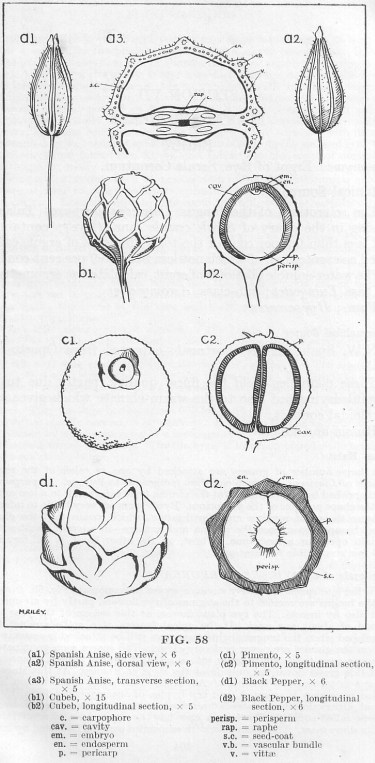 Tinctures
from Fresh Plants 10.41
Tinctures
from Fresh Plants 10.41
Fresh plant tinctures
may be considered an
improvement on that of that succi
however there are attendant problems that can only be resolved by resorting to
very lengthy procedures
Some homoeopathic pharmacopeias have attempted to address the matter but no method can be said to be more than a compromise solution, given the number of variables, not to mention species involved.
Tinctures and extracts prepared from dried plants represent the virtues of the plant in a concentrated form. The water content of fresh plants is subject to numerous variables, e.g. season or engorgement from wet weather etc.
Assume for the sake of an example that the average water content of fresh plant material is 75% and that of dried plant material to be 7.5%.
We may see that weight for weight 1g dried equals 10g fresh, therefore if an extraction process calls for a 1:4 ratio and we extracted 1kg of dried material in 4 litre of menstruum we would need to use 10kg of fresh to achieve an extraction of similar strength in terms of the plant�s soluble constituents.
The volume of 10kg of chopped plant is considerably greater than 4 litres of liquid. Remember the plant material cannot be pulverized because of the hydrolysis problem.
Even if the plant was reduced to a slurry we will end up with around 10 litres of liquid after filtration and we have completely destroyed the integrity of the menstruum, so the extraction would be incomplete.
Because of the volume problem, the ratio adopted for fresh material is 1:2, i.e., 1kg in 2 litre, therefore in comparison with the dried material the equivalent ratio is 1:20, i.e. 100g of dried material is the equivalent of 1kg fresh.Tinctures of fresh plants are prepared by the maceration process described in Section 10.23. We are of course still left with the problem of the integrity of the menstruum.
Homoeopathic pharmacists have devised various methods to overcome the problems. The methods are lengthy and imprecise. The methods include such procedures as determination of dry residue content of succi. Loss of weight on drying of fresh plants. Finally the integrity of the menstruum problem is tackled by using 86% alcohol to produce a final strength of circa 43% by volume.
Considerable precipitation occurs. Attempts to bring about a partial solution of the precipitated constituents is not very successful which leaves a question mark over the efficacy of the preparation.
As previously explained, tinctures of fresh plants are the equivalent of 1:20. A homoeopathic mother tincture is 1:10 therefore when producing the dilutions from them on the appropriate scale we proceed as follows;
1. The 1st decimal potency 1x = 2 parts fresh plant tincture in 8 parts menstruum of appropriate strength and succussed.
2. The 2nd decimal potency 2x = 1 part of 1x in 9 parts menstruum and succussed.
1. The 1st Centesimal potency 1C = 2 parts fresh plant tincture in 98 parts menstruum and succussed.
2. The 2nd Centesimal potency 2C = 1 part of 1C in 99 parts of menstruum and succussed.
This type of preparation is not recommended. To avoid problems always use dehydrated plant material. If the mother tincture is made from dried plant material the 1st dilution is always 1 part in 10 or 1 part in 100 as the case may be.
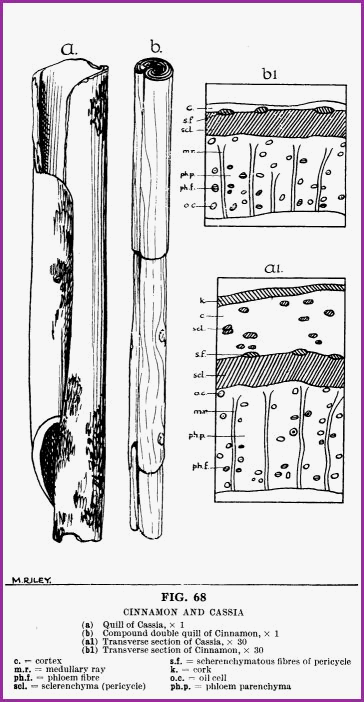 The
Extracts (Extracta) 10.42
The
Extracts (Extracta) 10.42
The extracts are the most important class of botanic preparations. They
represent the base substance from which all other classes are derived.
There are three distinct types;
1. The fluid extracts. As the name implies these are liquids containing the soluble extractive matter of a plant. They are so prepared that 1ml of fluid represents 1g of the standard air dried drug. The ratio is 1:1. From them may be prepared all other official concentrations and tinctures by dilution with a matching solvent.
2. The Soft Extracts. The soft extracts may be syrupy or pasty in consistence. They are prepared from fluid extracts by reduction of the menstruum by evaporation or distillation under low pressure. The soft extracts are used as the basis for creams, ointments, suppositories, lozenges and pills.
3. The Dry Extracts. The dry extracts may be in the form of powder, granules or scales. They are prepared from the soft extracts by means of a suitable drying process. Care must be taken not to use excessive heat lest damage occur. They are hygroscopic so must be kept in sealed containers in a cool dry place. The major use is in the preparation of tablets or capsules.
The fluid extracts are obtained by the percolation of the drug with an appropriate solvent and are superior to those preparations obtained by maceration in that a virtually complete extraction is achieved when the operation is correctly performed.
The Percolation
Method 10.43
Percolation is a method of extraction
achieved by the downward displacement of soluble extractive by a suitable
solvent through a suitably comminuted drug plant. The process is a
combination of maceration and percolation and is sometimes referred to as
a process of 'Macero-Percolation�. Not all plant drugs are suitable for
the process. There are 7 distinct operations involved, they are in order of operation;
1. Comminution. The principles of size reduction are covered in paragraph 10 -16. Remember if the particles are too fine a solid cake may occur, this will effect the downward flow of menstruum and will most certainly lead to the formation of �dry pockets� within the body of the material which will escape extraction. It the material is too coarse then interstices are formed through which there is a speedy percolation of menstruum which produces an incomplete extraction and will require excessive volumes of menstruum to exhaust the marc.
2.
Imbibition. The word is derived
from the Latin meaning
�to drink in�. The comminuted drug thoroughly moistened
with a portion of the menstruum. This is best done in a lidded container of a
suitable size. The moistened drug is allowed to stand for a period of four hours to allow the drug to
imbibe the menstruum
and thereby swell
to its maximum capacity. The container used should be
large enough to accommodate the expansion of the drug.
3. Packing. On completion of imbibition the drug should be passed through a number 10 sieve to break up any lumps that may have formed. The drug is then transferred to the percolation vessel in portions. Each portion should be firmly packed but not so firmly that liquid is forced from the drug but sufficient to exclude any air pockets.
4. Maceration. Open the stop cock on the bottom of the percolator and pour in the menstruum in portions and allow to percolate through the packed drug. If the menstruum drips through the stop cock in less than 10 minutes, the drug is too loosely packed. If the first drop takes 25 minutes or more then the drug is too tightly packed. If all is well, then close the stop cock and pour in sufficient menstruum to leave a layer 1 or 2 cm deep over the drug. Cover the percolator and leave to macerate for 48 hours in a warm dark place at a temperature not exceeding 25�C.
5. Percolation. On completion of maceration the percolation procedure is commenced. Slowly open the stop cock and adjust the flow of saturated menstruum to 10ml per minute for the first 10% of the total menstruum, thereafter adjust the flow to 10 drops per minute.
6. Adjustment. When the first 85% of the percolate has been collected, the receiver is changed and the first portion is reserved. The percolation into the fresh receiver is continued until the drug is exhausted. The marc is pressed and the expressed menstruum is mixed with the contents of the second receiver. That fluid is then reduced to a soft extract and then dissolved into the reserved 85% in the first receiver. The total is then adjusted to volume with a matching strength menstruum.
7. Clarification. The extract is sealed and allowed to stand in a cool dark place for a minimum of 48 hours (a week if times allow) after which it is filtered to remove any sedimentation and may then be considered ready for use. Correctly prepared and correctly stored the product will have a shelf life of 10 years.
Percolation Apparatus 10.44
Whenever possible such
apparatus as percolators should be made of glass for ease of cleaning and the
ability to make visual progress check. The percolator may be purpose built or
obtained from a laboratory supply house, or you may construct your own. The
general scheme may be as per the following diagram.
The Percolator. Figure 10.44A
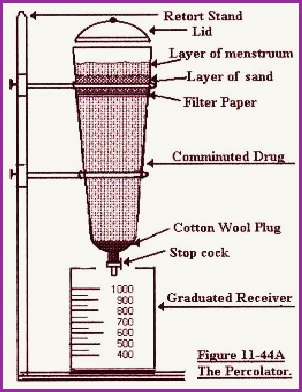 The
percolator should be cylindrical and if possible tapered, with a lid to fit
to prevent evaporation of a volatile menstruum.
The
percolator should be cylindrical and if possible tapered, with a lid to fit
to prevent evaporation of a volatile menstruum.
The packed drug is covered with a filter paper and a layer of clean sand to
maintain the packing without disturbance and the cotton wool plug is to prevent
the packed drug from being washed into the receiver.
Where possible the percolator and ancillary equipment should be of
sufficient size to contain all of the menstruum plus the drug. If this is not
possible then the bulk of the menstruum may be contained in a reservoir as
follows;
The level of menstruum will be maintained at the neck of the bottle until it
is empty, where upon it should be removed and replaced with the percolator lid.
To minimize loss of solvent by evaporation the opening of the
receiver/collector should be kept as small as possible; a graduated flat
bottomed boiling flask of a suitable size will serve the purpose well.
The Reservoir Figure 10.44B
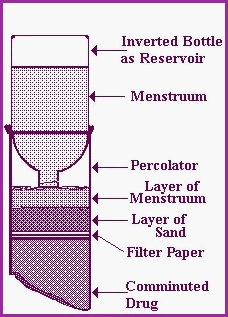 There are subsidiary methods of percolation for example a system of
re-percolation whereby the total drug to be extracted is divided into three parts; the ratio being 5, 3
and 2 respectively, that is, 500g, 300g, 200g = 1kg.
There are subsidiary methods of percolation for example a system of
re-percolation whereby the total drug to be extracted is divided into three parts; the ratio being 5, 3
and 2 respectively, that is, 500g, 300g, 200g = 1kg.
The total menstruum is passed through each part in succession. The method being similar to the �concentrated infusions�. The only benefit is that any subsequent evaporation is avoided.
In practice the procedure is lengthy and it is virtually impossible to extract the drug to exhaustion. Therefore, as a procedure it is not recommended. The following process is the recommended method which will meet most operational requirements and maintain the necessary standards.
The Reserve
Percolate Method 10.45
The percolation method of drug extraction may obviously be
used for the tinctures as well as the concentrated preparations. Therefore, the
volume of the menstruum needed to extract the drug to exhaustion will vary
according to the drug/menstruum ratio applied. Also, the strength of the
menstruum will vary depending on the material being operated on.
To arrive at an estimation of the volume of menstruum required proceed as follows;
For the purpose of example, let us suppose that we require 1000ml of a 1:4 tincture, i.e., 250gm of drug in 1 lt. From Paragraph 10.25 we will recall that 1gm of drug will hold around 1.5 times its own weight in menstruum when it is saturated; in addition an allowance of menstruum must be made for the Imbibition process. The following method for calculating the menstruum will in most cases be of reasonable accuracy.
Table10.45A. Tincture 1:4
| Volume of tincture required | 1000 ml |
| Volume required for saturation. (250g x 1.5) | 375 ml |
| Volume required for imbibition. (250 g x 0.5) | 125 ml |
| Total volume needed to complete extraction | 1500 ml |
| Liquid Extract 1:1 | ��� |
| Volume of extract required | 1000 ml |
| Volume required for saturation. (1000g x 1.5) | 1500 ml |
| Volume required for imbibition. (1000g x 0.5) | 500 ml |
| Total volume required to complete extraction | 3000 ml |
It will be seen from the table that the more concentrated the extract the greater the volume of menstruum needed to complete the extraction. The procedure to be followed is as described in Section 10.43.5 of that paragraph it is stated that the percolation is to proceed at 10 drops per minute. If the volume of the extract required exceeds 2 litres, the speed of percolation can be stepped up to 20 drops per minute, this is accounted for by the greater rate of displacement produced by the greater weight, of menstruum involved.
The first 85% of the required percolate is reserved, i.e., if 1000ml of extract is required then the first 850ml is placed to one side and stoppered to prevent evaporation or contamination. The percolation is then continued with a fresh receiving flask until the drug is exhausted.
For example in Table 10.45A, the 1:1 extract calls for 3000ml of menstruum. We collect and reserve the first 850ml leaving a balance of 2150ml for collection. It will be convenient to collect this in 2 or 3 receivers, in that way the progress of the extraction can be visually monitored. The collected menstruum will get progressively lighter in color as the amount of soluble extractive remaining in the drug declines with percolation.
When the percolate ceases to drip from the extractor, the marc is transferred to a linen or calico bag and subjected to pressure to express the remaining menstruum. In addition to the reserved percolate, there should now be just over 2 litres of weak extract which contains the remaining 15% of the total extract to be recovered, and added to the reserved percolate for adjustment to the required 1000ml.
For the purpose of illustration, assume that the drug required a 70% alcohol menstruum to effect the extraction and that the starting strength of the dilute alcohol was 95%. A perusal of Table 9.33A shows that the 70% alcohol contains 40 volumes of water, i.e., every 100ml of 70% menstruum contains 60ml of alcohol and 40ml of water.
From this 2 litre of percolate we reserve 150ml and place it to one side, to be used to dissolve the soft extract recovered from the remaining 1850ml of percolate.
The extract is recovered by reduction of the menstruum either by evaporation or distillation under reduced pressure. Whichever method of recovery is chosen the temperature must not be allowed to exceed 55�C lest damage to the extractive ensue.
It may be supposed that it would be far easier to simply reduce the 2 lt. of percolate to 150ml and add it to the reserve, however if we change the strength or composition of a menstruum, then precipitation will occur. In the reduction process the alcohol will be removed first, then followed by the reduction of water down to the required volume of 150ml. This is an aqueous percolate which if added to the 850ml of reserved percolate then a precipitation of the whole would occur; that is the reason for the somewhat lengthier procedure employed.
|
Summary of Process |
|
| A | Comminution |
| B | Imbibition (4 hours) |
| C | Maceration (48 hours) |
| D | Percolation (10 drops per minute) |
| E | Reserve the first 85% |
| F | Exhaust the drug |
| G | Reserve 150 ml percolate to adjust extract to volume |
| H | Reduce remainder to soft extract. Heat not above 55C |
| I | Dissolve soft extract in reserve percolate |
| J | Add reserve percolate to reserved extract. Adjust to volume |
| K | Seal and allow to stand for minimum 48 hours |
|
L |
Clarify by a single filtration |
The method of reduction by distillation under reduced pressure is favored over evaporation because the menstruum so recovered may be re-used and the temperature and duration of the process is considerably reduced. However if the menstruum is aqueous as it would be for an extract of malt or liquorice, then evaporation over a water bath will be found to be more convenient, given the larger quantities of substances involved. A flat bottomed evaporating pan facilitates the removal of the syrupy or pasty extracts.
The Soft and Dry Extracts
10.46
The soft and dry extracts
are of great service in the preparation of
pills, tablets, capsules, ointments
etc. or where the use of alcohol in a preparation is contra indicated. In such
cases a portion of the extract may be dissolved in warm water as a fresh
infusion or incorporated with the honey or syrup
The Soft Extracts 10.47
The soft extracts are syrupy or pasty in consistency. The alcohol has been removed and the water
content reduced. Remember that spoilage organisms thrive in the presence of
water therefore the water must be reduced to 5%
if they are to be stored. Prepare them as follows.
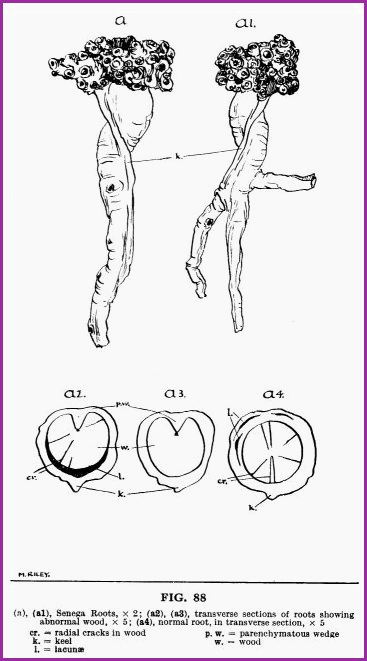 1. Produce a fluid extract
with the appropriate menstruum. When the drug has been exhausted all of the
menstruum may be mixed, i.e., the reserve percolate method is not resorted to.
1. Produce a fluid extract
with the appropriate menstruum. When the drug has been exhausted all of the
menstruum may be mixed, i.e., the reserve percolate method is not resorted to.
2. Fraction out the alcohol by distillation under reduced pressure. The alcohol recovered for Galenic preparations is reused after it has been rectified. For Spagyric or Homoeopathic work the recovered menstruum may only be employed for the original specie used.
3. Transfer the remaining fluid to a water bath to effect removal of the bulk of water. The temperature of the water bath should not exceed 60�C and should preferably be maintained at 50�C. This is most important if hydrolysis or the Racemization (L and D isomers) of the extraction is to be avoided. The heat loss involved by transfer from the water to the evaporating pan is usually circa 5�C, therefore, temperature control is a must.
4. The evaporating pan should be as large and as shallow as possible. The larger the surface area of the extract which is exposed to the atmosphere the swifter the evaporation. The extract must be stirred on a regular basis to break up the film or skin which forms on the surface of the extract. If this is not done, the evaporation process is retarded. Racemization may also occur due to an overlong evaporation procedure. If the quantity of the extract involved is large then it may be divided into portions and evaporated separately. All portions must be operated on within 12 hours lest spoilage by micro organisms occur.
5. When it is judged that the extract is at the consistency required, take a small porcelain crucible and accurately weigh it. Take a small portion of the extract and transfer it to the crucible. Re-weigh the crucible and tare it, i.e., subtract the weight of the crucible to obtain the weight of the extract. Gently heat to reduce the extract to a dry state and allow to cool. Re-weigh and tare. The difference in weight between the liquid and dried extract is the amount of water it contains.
6. When the desired consistency is reached, the extract may then be transferred to sterile storage containers, tightly sealed and stored in a cool dark place. Shelf life is circa 12 weeks.
The Dry Extracts
10.48
When a fluid extract is reduced to a dry state by evaporation in the
atmosphere, it is hygroscopic and tends to produce a dense intractable mass which is difficult to work
with, dissolve or to store. Those problems may be circumvented by reducing the soft extract to 1 of 2 forms,
i.e., scales or granules.
The Dry Scales 10.49
1. The syrupy soft extract
is painted or very thinly spread with a
spatula onto sheets of heat resistant glass or Pyrex ovenware. The extract is
then dried in a cool oven at a
temperature not exceeding 40�C. At no time should the
extract be exposed to direct radiant
heat or treated in a microwave oven lest irremediable
damage occur.
The Granulated
Extracts
Figure
10.49A
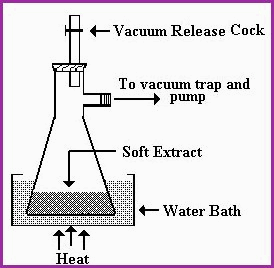 1.
The syrupy warm extract
is transferred to a strengthened
Buchner filter flask which is suspended in a water bath.
1.
The syrupy warm extract
is transferred to a strengthened
Buchner filter flask which is suspended in a water bath.
2. The flask is attached to a vacuum pump or venturi tube The system is then sealed and the vacuum pump turned on and the pressure inside the flask quickly reduced. There will be a sudden evolution of water vapor causing the extract to balloon into a porous friable mass.
3. Slowly open the vacuum release cock and turn off the pump. Remove the flask from the water bath.
4. The friable mass may be dislodged from the Buchner flask by means of a glass stirring rod. Rub the mass through a 14 mesh sieve and store as for the dried scales.
5. The Buchner flask should not stand in the boiling water any longer than three minutes before the vacuum pump is turned on.
Supplementary Procedures 10.50
Some plant materials contain lipids,
i.e., waxes, fats and oils. They are usually seeds or fruits, (essential oils are not lipids, except
in rare instances). For example, oil seeds, they are not present in
such quantity so as to materially effect the extraction procedure, however they will cause problems when
attempting to produce a soft extract
and will render a dry extract
impossible due to the oily nature of the reduced extract. The
procedure to remove the oil is called de-fatting. It is carried out as follows.
|
1 |
For each litre of fluid extract take 25g of hard paraffin wax and grate it in the same manner as hard cheese and add it to the extract. |
| 2 | On a water bath, warm the extract to just above melting point of the wax which is circa 60� C. Hold it at that temperature for three minutes then remove the extract from the heat, stir thoroughly and allow to cool |
| 3 | The oil in suspension will incorporate with the melted wax, which on cooling will form a solid layer on the surface of the extract, from where it may be easily removed. The fluid extract is then ready for the reduction process. |
Continuous Hot
Extraction 10.51
The extraction of a solute from a solid by
means of a cold solvent is a
slow process but it is a necessity
if the integrity
of the solute is to be maintained. However many routine analytic tasks
performed in a laboratory are concerned with elemental constituents
rather than the molecular structure.
The need was for speedy delivery of small quantities of substances for routine
analysis; this was achieved by the continuous hot percolation method.
The piece of equipment used is a standard to most laboratories and is known as the �Soxhlet Extractor�, named after a German agricultural chemist Franz von Soxhlet (1848 -1926).
Soxhlet Extractor
Figure 10.51A
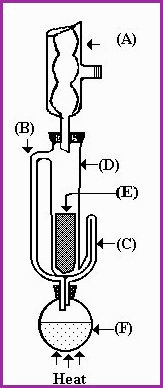
(A)
Reflux condenser
(B) Hot vapor tube
(C)
Percolate return tube (by siphon)
(D) Soxhlet Extractor (Body)
(E) Extraction Thimble
(F) Boiling flask.
The path of the solvent is;
(F) - (B) - (A) - (D) - (E) - (C) - (F)
The hot solvent vapors pass from flask (F) and rise through tube (B) and condenses in (A). The lukewarm liquid then drips into thimble (E) where it percolates through the substance contained in the thimble. The percolate from (E) passes to (C) where it rises until its height matches that in (E) when it will automatically siphon back to (F).
So long as the boiling flask (F) is heated the process will be continuous; between 10 and 15 cycles, depending on the substance will be needed to exhaust it. The two major points here are,
1. The substance is extracted with lukewarm condensed solvent and not hot;
2. The soluble substance extracted, remains in the boiling flask and is subjected to the heat of the boiling solvent for in excess of 30 minutes. It will be clearly understood that such a process is too violent and destructive to be of use in extracting plant materials. However it is of major importance when preparing a Spagyric tincture or extract where it is used to extract the soluble salts from the extracted marc. The Spagyric method will be covered later in the text.
An Alternative Continuous Extraction Apparatus 10.52.
The Soxhlet apparatus is
delicate and expensive if broken; it is prone , if the thimble is too tightly
packed to leave a dry core of un-extracted material, so that the procedure would
need to be repeated. Those problems may be avoided by using alternative
extractors which are commercially available, e.g.,
Figure 10.52A
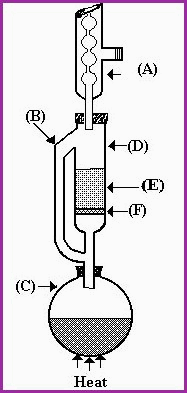
(A) Reflux Condenser
(B) Hot Vapor Tube
(C) Boiling Flask
(D) Body of Extractor
(E) Substance for extraction
(F) Sintered Glass Filter Plate
The path of the solvent is;
(C) - (B) - (A) - (D) - (E) - (F) - (C)
The alternative is
relatively cheap and less prone to breakage. It has proven to be satisfactory
when used in the Spagyric process. A 20 minute circulation will exhaust a
calcined marc of its soluble salts.
The Essential or Volatile Oils 10.53
As a class of product the essential/volatile oils
are commercially important and because of
the large quantities of base material required to obtain a relatively small
yield they are also expensive.
Table 10.53A Average Yields
|
Common Name. |
Botanical Name. |
% Yield. |
| Arnica Flowers | Arnica montana |
0.04% |
| Basil Herb | Ocimum basilicum |
0.04% |
| Chamomile Flowers | Matricaria chamomilla |
0.50% |
| Hyssop Herb | Hyssopus officinalis |
0.40% |
| Lavender Flowers | Lavandula vera |
2.90% |
| Lemon Balm Herb | Melissa officinalis |
0.10% |
| Peppermint Herb | Mentha piperita |
0.30% |
| Rose Flowers | Rosa spp. |
0.01% |
| Rosemary Herb | Rosmarinus officinalis |
1.55% |
| Sage Herb | Salvia officinalis |
1.40% |
| Tansy Herb | Tanacetum vulgare |
0.15% |
| Violet Flowers | Viola odorata |
0.03% |
| Wormwood Herb | Artemisia absinthium |
0.35% |
The oils are plant isolates are used for perfumery, flavoring and medicines. It must be emphasized that medicinally they are not the equivalent of the tinctures and extracts and only display a narrow band of a plant�s full therapeutic spectrum. Taken internally they can be extremely toxic, to the point of fatality. Externally they are irritant/rubefacient and should not be used in the undiluted form, especially around the eyes or on mucous membrane.
Orthodox medicine employ them internally in dilute form as digestives or carminatives and occasionally as inhalants where they are of great service due to their volatile nature and undoubted bactericidal properties. As a product they are used by a branch of complementary medicine called �Aromatherapy� where the volatile oils are diluted in a fixed oil and applied externally.
Occurrence and Nature 10.54
The study of function and genesis of any constituent, in a living organism
is problematic, and conclusions are constantly being revised. The essential oils
are sometimes referred to
as pseudo-lipids because like
the oils and fats they are soluble in organic solvents,
it is there that any similarity ends. The volatile oils have their genesis in
the chlorophyllic soft tissue (parenchyma) of the plant and are a secondary
metabolite of the photo-synthetic process.
There is no firm agreement as to their function in the plant economy. However, they are to be found in all green plants, but they are not obtained from all possible sources, in that they do not exist in sufficient quantity in the free form (terpenes) to make the recovery an economic proposition.
Even if they are not present as terpenes they will most certainly be present as a complex but locked into the molecular structure of many Glucosides. It is probably for this reason that some authorities maintain that the oils are the result of a pathological process, e.g., oleo-resins resulting from a wound to a plant, or in other cases when a plant is crushed, a ruptured enzyme bearing structure, is in contact with a normally separated glucosidal structure, and in the ensuing hydrolysis the oil is released.
The oils are to be found in greater or lesser quantities in all parts of the plant and migrate to stems and roots in an aqueous solution of plant solutes. Contrary to popular belief the volatile oils with the exception of those containing 50% or more terpenes are sparingly or slightly soluble in water. For example distilled peppermint water.
Table 10.54A Examples of solubility
|
Volatile Oil |
Water in Oil |
| Bergamot | 1:300 |
| Clove | 1:210 |
| Eucalyptus | 1:620 |
| Geranium (Turkish) | 1:90 |
| Lemon Grass (Java) | 1:130 |
| Thyme | 1:220 |
| Sandalwood. | 1:590 |
This fact is also evident when water from an oil distillation process is returned to the still, an appreciable yield of oil is obtained. The solubility point is important because it provides a satisfactory answer as to the genesis, fate and excretion of the oils within the plant economy at different stages of growth, i.e., when the solute changes in volume or composition within the plant itself, precipitation occurs in the vicinity of, or at the site of the plants excretory organs.
How much oil is secreted or precipitated in any one place is determined by the plant�s stage of growth, for example, oils may be directed from leaves to flowers via stems or locked into molecules of complex carbohydrates which are stored in tuberous parts; e.g., when distilling certain varieties of potatoes for spirit, a distinct odor of rose petals is noticeable. So obviously, the plant is able to direct the migration by means of solubility gradients. Because of the variable nature of plants of the same species it is common to use a descriptive term to designate solubility, i.e.,
Table 10.54B Solubility Terms
| Very soluble | less than 1:1 |
| Freely soluble | from 1:1 to 1:10 |
| Soluble | from 1:10 to 1:30 |
| Sparingly soluble | from 1:30 to 1:100 |
| Slightly soluble | from 1:100 to 1:1000 |
| Practically insoluble | from 1:1000 to 1:10,000 |
Odour Extraction 10.55
Many methods have been devised
for the extraction of the essential oils for perfumes, not all of which are
suitable for natural cosmetic purposes. The methods may be summarized as
follows;
| A | Distillation in steam or water |
| B | Maceration in fixed oils |
| C | Extraction in volatile liquids |
| D | By pressure or scarification |
| E | Enfleurage |
Maceration and Enfleurage 10.56
Both methods rely upon �absorption� the major difference is temperature and
technique. The Maceration method employs heated
oils or fats (lipids) The Enfleurage method employs fats at room
temperature. For mainly economic reasons, only a very few volatile oils are
extracted by maceration or Enfleurage. Such products although of excellent
quality are astronomically priced, which in turn has depressed demand in the
market place.
The Maceration Method
10.57
Flower petals in linen bags are suspended in heated oil or fat. The temperature of which should not be allowed
to exceed 40�C.
for the best results.
The maceration time will depend upon the condition and type of material that is operated on. This is normally a minimum of 8 hours and a maximum of 48 hours.
When it is judged that the petals have yielded the perfume, the bags are removed and passed through a small roller press to express the impregnated oil. The bags are then recharged with fresh petals and the process is repeated as often as is necessary to produced the required strength of product.
If the product is an item of commerce, its strength is designated by the number of times fresh petals were extracted in the batch. Standard commercial extractive numbers are usually from 15 to 25, it will be understood that considerable time and labour are involved.
If an oil is used as the maceration vehicle, the product is known as a �Perfumed Oil� or �Huiles Antiques�. If a fat is used. it is allowed to solidify and designated as a �Pomade�. Such products are then on sold for further processing. They are appropriately labeled with their extraction numbers, for example;
Violet Oil. Number 20. 1000 ml. Violet Pomade. Number 20. 800g.
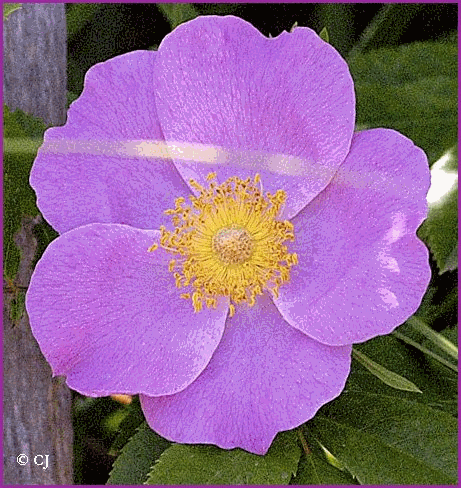 The
Enfleurage Method 10.58
The
Enfleurage Method 10.58
This method is usually
reserved for very delicate odours where extraction by heated oils or fats is
judged too harsh. Accordingly the room temperature method is used.
Glass plates such as standard window glass are coated in a purified fat. The fat is usually Lard (Hog Fat) Petals were then sprinkled onto the fat and left to yield the perfume to the fat. When the petals present a wilted appearance the extraction is complete. This can take between 24 and 72 hours depending on the composition of the petals. The flower petals are then removed and replaced with fresh for as often as necessary to reach the desired commercial strength.
Preparation of Enfleurage Plates 10.59
The easiest method is to pre-melt the fat and dip the glass plates. Take two
plates together (back to back) and dip them at the same time. Support them on a
wire cake rack, under which grease proof paper is placed, and allowed to cool.
A minimum of 2 mm layer will be required. If necessary the plates are dipped again until a suitable layer has been formed. The back to back plates may then be separated and are ready for use. A small airtight cupboard will be needed into which the plates may be inserted as shelves.
The purity of the oil or fat must be of the very best, lest the perfume oils are contaminated with residual odours from rancidity break down products.
Extraction of Oils by Pressure 10.60
This method is used for the
citrus oils where considerable quantities are found in small oil glands within
the rind of the fruit. The citrus oils have many commercial applications. For
example �Oil of Bergamot� this is the oil of the Bergamot
orange and not that of the herbs represented by the Monarda family.
Extraction by Volatile Liquids 10.61
The volatile liquids
used in
commerce are usually fairly selective as to what is actually extracted and are
of a low boiling point (bp) for example;
|
Solvent |
bp |
Remarks |
| Light Petroleum | 40 - 60�C | Toxic Petroleum Ether, highly inflammable |
| Chloroform | 61�C | Carcinogenic Vapour, non inflammable |
| Benzene | 80�C | Toxic, inflammable |
| Carbon Tetrachloride | 77�C | Highly toxic, non inflammable |
The fresh plant material is subjected to the action of the solvent. The solvent is then distilled off. This leaves a product at the bottom of the distillation vessel which is known as a �Floral Concrete�. The concretes are composed of oils, waxes, colouring matter and albumin etc.
The Concrete must be further processed to remove unwanted components. The product is called an �Absolute�. Perfumes produced by such methods are inferior to those produced by Maceration or Enfleurage. Alcohol may be used but it is considered to be non selective.
Library![]()